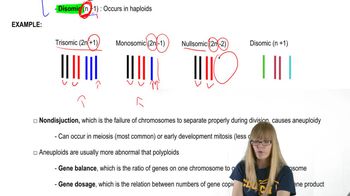Here are the essential concepts you must grasp in order to answer the question correctly.
Chromosome Number Abnormalities
Chromosome number abnormalities occur when there is a deviation from the normal diploid number of chromosomes, which is 46 in humans. These abnormalities can manifest as aneuploidy, where there is an extra or missing chromosome, or polyploidy, where there are multiple sets of chromosomes. In the case of Down syndrome, the presence of an extra chromosome 21 results in trisomy 21, leading to the characteristic features of the condition.
Recommended video:
Aneuploidy
Aneuploidy is a specific type of chromosome number abnormality characterized by the presence of an abnormal number of chromosomes in a cell. This can include conditions such as monosomy (one less chromosome) or trisomy (one extra chromosome). In the context of the question, the boy with Down syndrome has trisomy 21, indicating he has three copies of chromosome 21 instead of the usual two, while his family members have a normal chromosome count.
Recommended video:
Phenotype vs. Genotype
Phenotype refers to the observable physical and biochemical characteristics of an organism, which result from the interaction of its genotype with the environment. In this scenario, the boy with Down syndrome has a distinct phenotype due to his genetic makeup, while his parents and sisters, despite having a normal phenotype, have an unusual chromosome count of 45, suggesting a potential genetic anomaly that may not be phenotypically expressed.
Recommended video:
 Verified step by step guidance
Verified step by step guidance Verified video answer for a similar problem:
Verified video answer for a similar problem:



 12:42m
12:42m